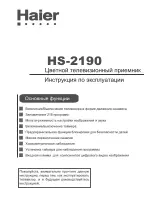
English - 6
Pressing
ToolS
button to enter
DUAl I-II
controls the
processing and output of the audio signal. When power is
switched on, the mode is automatically preset to either “Dual-I
” or “Stereo”, depending on the current transmission.
Selecting the Sound Mode
(depending on the model)
➢
◆
If the receiving conditions deteriorate, listening will
be easier if the mode is set to the
Mono
.
◆
If the stereo signal is weak and an automatic
switching occurs, then switch to the
Mono
.
◆
When receiving a mono sound in the AV mode,
connect to the “AUDIO-L” input connector on the
panel (front or side). If the mono sound comes out
only from left speaker, press the
ToolS
button to
enter
DUAl I-II.
◆
NICAM Stereo
Type of broadcast
Mono
(Normal use)
Dual-I
NICAM
Dual-II
NICAM
Mono
(Normal)
↔
↔
R
NICAM Mono
Regular broadcast
(Standard audio)
NICAM Dual-I/II
on-screen indication
Mono
NICAM
Mono
(Normal)
↔
NICAM Stereo
Stereo
NICAM
Mono
(Normal)
↔
◆
A2 Stereo
Type of broadcast
Mono
(Normal)
Bilingual or Dual-I/II
Regular broadcast
(Standard audio)
on-screen indication
Dual-I
↔
Dual-II
Stereo
Stereo
Mono
(Forced mono)
↔
Easy View is a combination of Video&Audio features that
make TV viewing much easier.
You can press
ToolS
button to enter
Easy View
.
Channel minimizer is a feature
that offers freedom in the
number of channels that you can
watch at any time!
To add a Channel
You can go to your favorite
channel you wish to add to
Channel Minimizer.
Method
:
▲ : Add the present channel to Channel Minimizer.
➢
Repeat the process to add upto six channels.
To delete a Channel
You can delete the channel in Channel Minimizer by pressing
▼ button.
Easy View - Channel Minimizer
Standard screen format televisions (4:3, the aspect ratio of
the screen width to height) are primarily designed to view
standard format full-motion video.
The images displayed on them should primarily be in the
standard 4:3 ratio format and constantly moving. Displaying
stationary graphics and images on screen, such as the
dark top and bottom letterbox bars (wide screen pictures),
should be limited to no more than 15% of the total television
viewing per week.
Wide screen format televisions (16:9, the aspect ratio of
the screen width to height) are primarily designed to view
wide screen format full-motion video. The images displayed
on them should primarily be in the wide screen 16:9 ratio
format, or expanded to fill the screen if your model offers
this feature, and constantly moving. Displaying stationary
graphics and images on screen, such as the dark side-
bars on non-expanded standard format television video and
programming, should be limited to no more than 15% of the
total television viewing per week.
Additionally, viewing other stationary images and text such
as stock market reports, video game displays, station logos,
web sites or computer graphics and patterns, should be
limited as described above for all televisions. Displaying
any stationary images that exceed the above guidelines
can cause uneven aging of picture tubes (CRTs) that
leave subtle, but permanent burned-in ghost images in the
television picture. To avoid this, vary the programming and
images, and primarily display full screen moving images,
not stationary patterns or dark bars.
On television models that offer picture sizing features, use
these controls to view the different formats as a full screen
picture.
Be careful in the selection and duration of television formats
used for viewing. Uneven CRT aging as a result of format
selection and use, as well as other burned-in images, is not
covered by your Samsung limited warranty.
Important Warranty Information
regarding Television Format Viewing
Easy View
Move
Enter
Exit
Channel Grouping
►
Channel Minimizer
►
Channel Scheduler
►
Music Mode
►
Half Mute
►
Scroll
Select
▼
Delete
Scroll
Select
▼
Delete
P14
P20
P35
AA68-03972K.indd 6
2009-08-13 �� 10:47:44


























